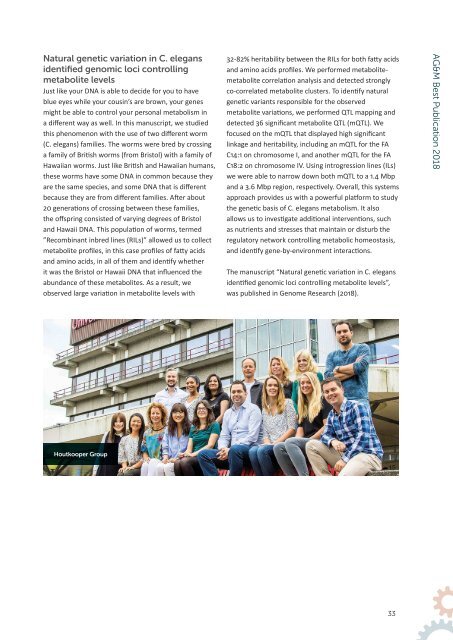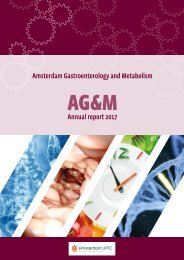AG&M annual report 2018
Create successful ePaper yourself
Turn your PDF publications into a flip-book with our unique Google optimized e-Paper software.
Natural genetic variation in C. elegans<br />
identified genomic loci controlling<br />
metabolite levels<br />
Just like your DNA is able to decide for you to have<br />
blue eyes while your cousin’s are brown, your genes<br />
might be able to control your personal metabolism in<br />
a different way as well. In this manuscript, we studied<br />
this phenomenon with the use of two different worm<br />
(C. elegans) families. The worms were bred by crossing<br />
a family of British worms (from Bristol) with a family of<br />
Hawaiian worms. Just like British and Hawaiian humans,<br />
these worms have some DNA in common because they<br />
are the same species, and some DNA that is different<br />
because they are from different families. After about<br />
20 generations of crossing between these families,<br />
the offspring consisted of varying degrees of Bristol<br />
and Hawaii DNA. This population of worms, termed<br />
”Recombinant inbred lines (RILs)” allowed us to collect<br />
metabolite profiles, in this case profiles of fatty acids<br />
and amino acids, in all of them and identify whether<br />
it was the Bristol or Hawaii DNA that influenced the<br />
abundance of these metabolites. As a result, we<br />
observed large variation in metabolite levels with<br />
32-82% heritability between the RILs for both fatty acids<br />
and amino acids profiles. We performed metabolitemetabolite<br />
correlation analysis and detected strongly<br />
co-correlated metabolite clusters. To identify natural<br />
genetic variants responsible for the observed<br />
metabolite variations, we performed QTL mapping and<br />
detected 36 significant metabolite QTL (mQTL). We<br />
focused on the mQTL that displayed high significant<br />
linkage and heritability, including an mQTL for the FA<br />
C14:1 on chromosome I, and another mQTL for the FA<br />
C18:2 on chromosome IV. Using introgression lines (ILs)<br />
we were able to narrow down both mQTL to a 1.4 Mbp<br />
and a 3.6 Mbp region, respectively. Overall, this systems<br />
approach provides us with a powerful platform to study<br />
the genetic basis of C. elegans metabolism. It also<br />
allows us to investigate additional interventions, such<br />
as nutrients and stresses that maintain or disturb the<br />
regulatory network controlling metabolic homeostasis,<br />
and identify gene-by-environment interactions.<br />
The manuscript “Natural genetic variation in C. elegans<br />
identified genomic loci controlling metabolite levels”,<br />
was published in Genome Research (<strong>2018</strong>).<br />
AG&M Best Publication <strong>2018</strong><br />
Houtkooper Group<br />
33



